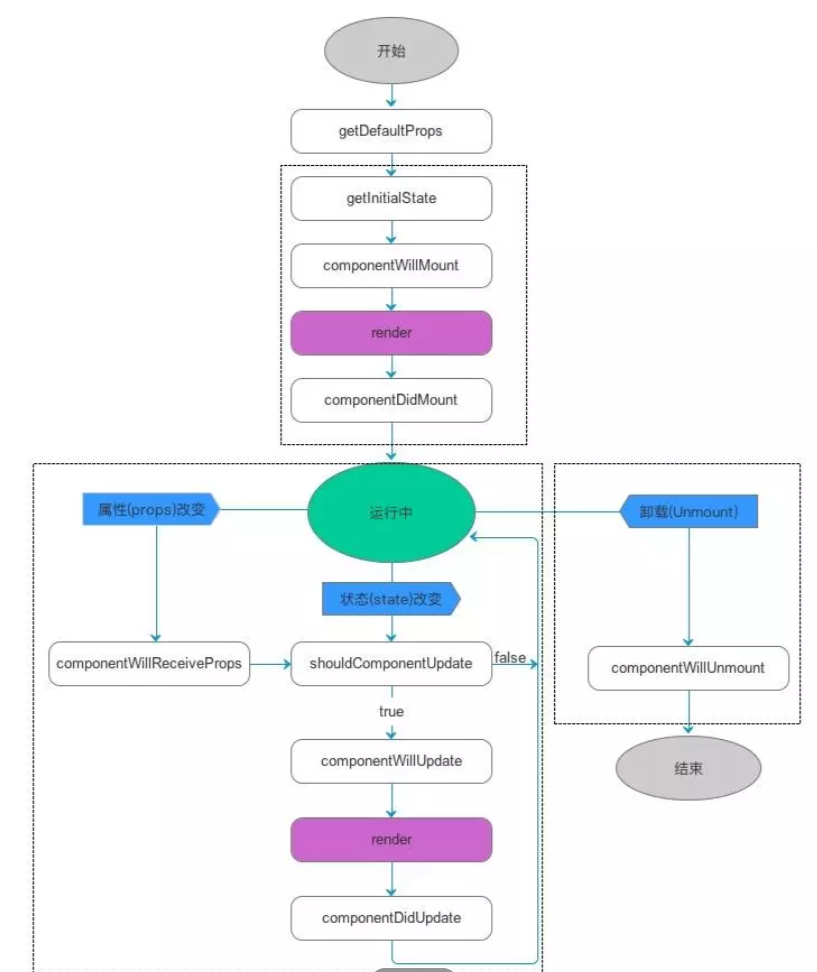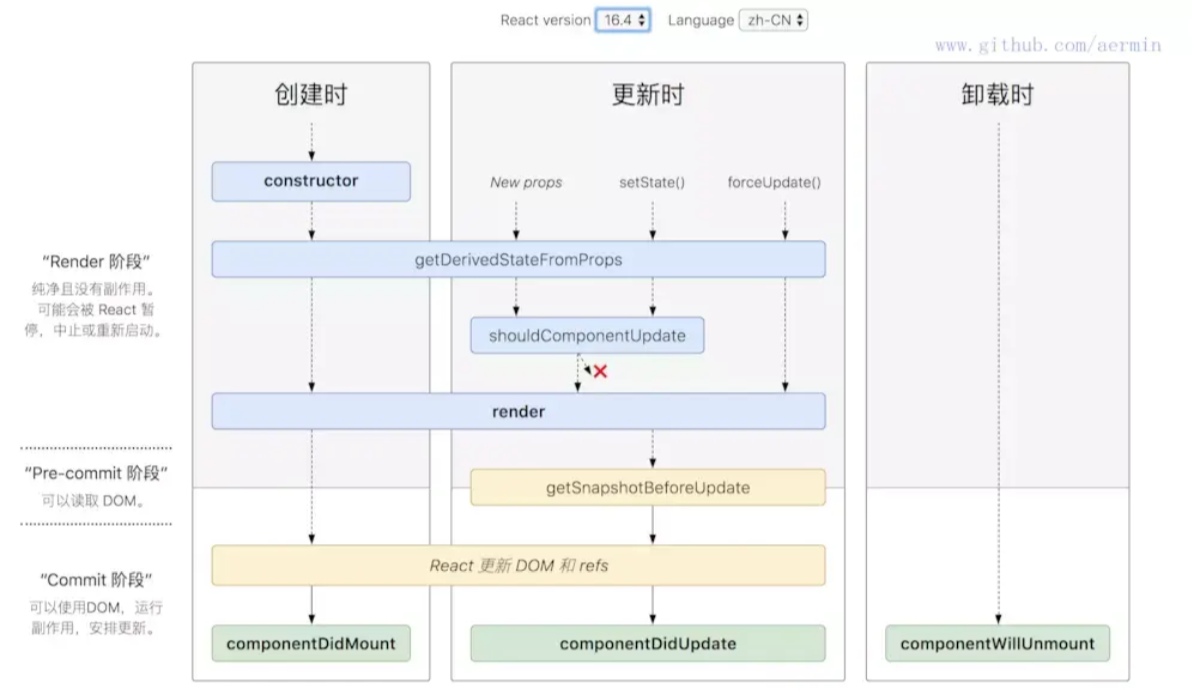组件的生命周期可分成三个状态:
- Mounting:已插入真实 DOM
- Updating:正在被重新渲染
- Unmounting:已移出真实 DOM
生命周期的方法有:
-
componentWillMount 在渲染前调用,在客户端也在服务端。
-
componentDidMount : 在第一次渲染后调用,只在客户端。之后组件已经生成了对应的DOM结构,可以通过this.getDOMNode()来进行访问。 如果你想和其他JavaScript框架一起使用,可以在这个方法中调用setTimeout, setInterval或者发送AJAX请求等操作(防止异步操作阻塞UI)。
-
componentWillReceiveProps 在组件接收到一个新的 prop (更新后)时被调用。这个方法在初始化render时不会被调用。
-
shouldComponentUpdate 返回一个布尔值。在组件接收到新的props或者state时被调用。在初始化时或者使用forceUpdate时不被调用。
可以在你确认不需要更新组件时使用。 -
componentWillUpdate在组件接收到新的props或者state但还没有render时被调用。在初始化时不会被调用。
-
componentDidUpdate 在组件完成更新后立即调用。在初始化时不会被调用。
-
componentWillUnmount在组件从 DOM 中移除之前立刻被调用
实例:
以下实例在 Hello 组件加载以后,通过 componentDidMount 方法设置一个定时器,每隔100毫秒重新设置组件的透明度,并重新渲染:
class Hello extends React.Component{ constructor(props){ super(props); this.state={opacity:1.0}; } componentDidMount(){ this.timer=setInterval(() => { var opacity=this.state.opacity; opacity-=0.05; if(opacity<0.1){ opacity=1.0; } this.setState({ opacity:opacity }) },100); } render(){ return( <div style={{opacity: this.state.opacity}}> Hello {this.props.name} </div> ) } } ReactDOM.render( <Hello name="world!"/>, document.getElementById("app") );
以下实例初始化 state , setNewnumber 用于更新 state。所有生命周期在 Content 组件中。
class Button extends React.Component{ constructor(props){ super(props); this.state={ data:0 } this.setNewNumber=this.setNewNumber.bind(this); } setNewNumber(){ this.setState({ data:this.state.data+1 }) } render(){ return( <div> <button onClick={this.setNewNumber}>增加</button> <Content myNumber={this.state.data}/> </div> ) } } class Content extends React.Component{ componentWillMount(){ console.log("渲染前") } componentDidMount(){ console.log("第一次渲染完毕!") } componentWillReceiveProps(newProps){ console.log("接收到新值,更新完毕") } shouldComponentUpdate(newProps, newState){ return true; } componentWillUpdate(nextProps, nextState) { console.log('接到新值,即将更新dom'); } componentDidUpdate(prevProps, prevState) { console.log('组件完成更新后立即调用'); } componentWillUnmount() { console.log('组件即将重dom中移除') } render() { return ( <div> <h3>{this.props.myNumber}</h3> </div> ); } } ReactDOM.render( <div> <Button /> </div>, document.getElementById('app') );
。
个人理解:
React的生命周期从广义上分为三个阶段:挂载、渲染、卸载
因此可以把React的生命周期分为两类:挂载卸载过程和更新过程。
React的生命周期图:

1. 挂载卸载过程
1.1.constructor()
注意:只要使用了constructor()就必须写super(),否则会导致this指向错误。
1.2.componentWillMount()
componentWillMount()一般用的比较少,它更多的是在服务端渲染时使用。它代表的过程是组件已经经历了constructor()初始化数据后,但是还未渲染DOM时。
1.3.componentDidMount()
组件第一次渲染完成,此时dom节点已经生成,可以在这里调用ajax请求,返回数据setState后组件会重新渲染
1.4.componentWillUnmount ()
在此处完成组件的卸载和数据的销毁。
- clear你在组建中所有的setTimeout,setInterval
- 移除所有组建中的监听 removeEventListener
- 有时候我们会碰到这个warning:
Can only update a mounted or mounting component. This usually means you called setState() on an unmounted component. This is a no-op. Please check the code for the undefined component.
原因:因为你在组件中的ajax请求返回setState,而你组件销毁的时候,请求还未完成,因此会报warning
解决方法:
componentDidMount() { this.isMount === true axios.post().then((res) => { this.isMount && this.setState({ // 增加条件ismount为true时 aaa:res }) }) } componentWillUnmount() { this.isMount === false }
2. 更新过程
2.1. componentWillReceiveProps (nextProps)
- 在接受父组件改变后的props需要重新渲染组件时用到的比较多
- 接受一个参数nextProps
- 通过对比nextProps和this.props,将nextProps的state为当前组件的state,从而重新渲染组件
componentWillReceiveProps (nextProps) { nextProps.openNotice !== this.props.openNotice&&this.setState({ openNotice:nextProps.openNotice },() => { console.log(this.state.openNotice:nextProps) //将state更新为nextProps,在setState的第二个参数(回调)可以打 印出新的state }) }
2.2.shouldComponentUpdate(nextProps,nextState)
- 主要用于性能优化(部分更新)
- 唯一用于控制组件重新渲染的生命周期,由于在react中,setState以后,state发生变化,组件会进入重新渲染的流程,在这里return false可以阻止组件的更新
- 因为react父组件的重新渲染会导致其所有子组件的重新渲染,这个时候其实我们是不需要所有子组件都跟着重新渲染的,因此需要在子组件的该生命周期中做判断
2.3.componentWillUpdate (nextProps,nextState)
shouldComponentUpdate返回true以后,组件进入重新渲染的流程,进入componentWillUpdate,这里同样可以拿到nextProps和nextState。
2.4.componentDidUpdate(prevProps,prevState)
2.5.render()
3. React新增的生命周期(借鉴别人)

3.1. getDerivedStateFromProps(nextProps, prevState)
老版本中的componentWillReceiveProps()方法判断前后两个 props 是否相同,如果不同再将新的 props 更新到相应的 state 上去。这样做一来会破坏 state 数据的单一数据源,导致组件状态变得不可预测,另一方面也会增加组件的重绘次数。
举个例子:
// before componentWillReceiveProps(nextProps) { if (nextProps.isLogin !== this.props.isLogin) { this.setState({ isLogin: nextProps.isLogin, }); } if (nextProps.isLogin) { this.handleClose(); } } // after static getDerivedStateFromProps(nextProps, prevState) { if (nextProps.isLogin !== prevState.isLogin) { return { isLogin: nextProps.isLogin, }; } return null; } componentDidUpdate(prevProps, prevState) { if (!prevState.isLogin && this.props.isLogin) { this.handleClose(); } }
这两者最大的不同就是:
在 componentWillReceiveProps 中,我们一般会做以下两件事,一是根据 props 来更新 state,二是触发一些回调,如动画或页面跳转等。
- 在老版本的 React 中,这两件事我们都需要在 componentWillReceiveProps 中去做。
- 而在新版本中,官方将更新 state 与触发回调重新分配到了 getDerivedStateFromProps 与 componentDidUpdate 中,使得组件整体的更新逻辑更为清晰。而且在 getDerivedStateFromProps 中还禁止了组件去访问 this.props,强制让开发者去比较 nextProps 与 prevState 中的值,以确保当开发者用到 getDerivedStateFromProps 这个生命周期函数时,就是在根据当前的 props 来更新组件的 state,而不是去做其他一些让组件自身状态变得更加不可预测的事情。
3.2. getSnapshotBeforeUpdate(prevProps, prevState)
常见的 componentWillUpdate 的用例是在组件更新前,读取当前某个 DOM 元素的状态,并在 componentDidUpdate 中进行相应的处理。
这两者的区别在于:
- 在 React 开启异步渲染模式后,在 render 阶段读取到的 DOM 元素状态并不总是和 commit 阶段相同,这就导致在
componentDidUpdate 中使用 componentWillUpdate 中读取到的 DOM 元素状态是不安全的,因为这时的值很有可能已经失效了。 - getSnapshotBeforeUpdate 会在最终的 render 之前被调用,也就是说在 getSnapshotBeforeUpdate 中读取到的 DOM 元素状态是可以保证与 componentDidUpdate 中一致的。
此生命周期返回的任何值都将作为参数传递给componentDidUpdate()。
。